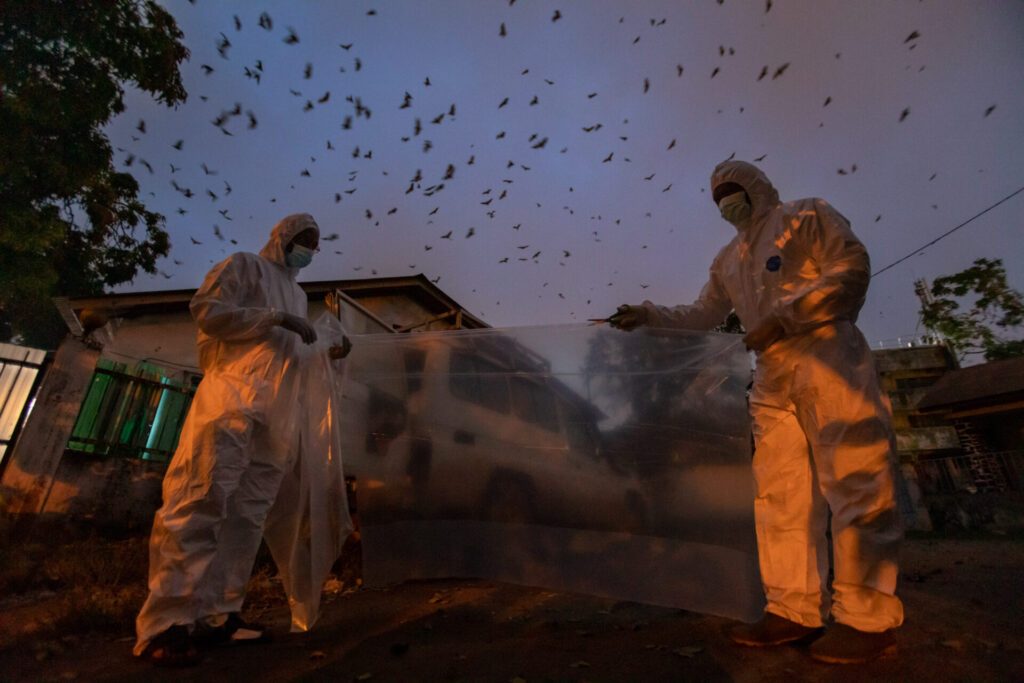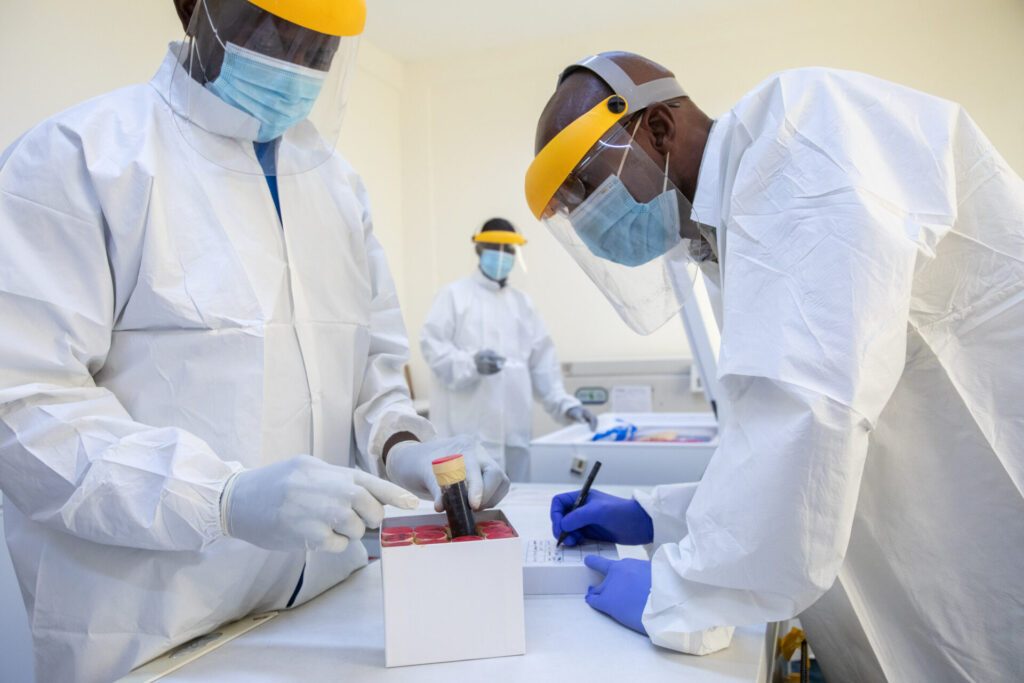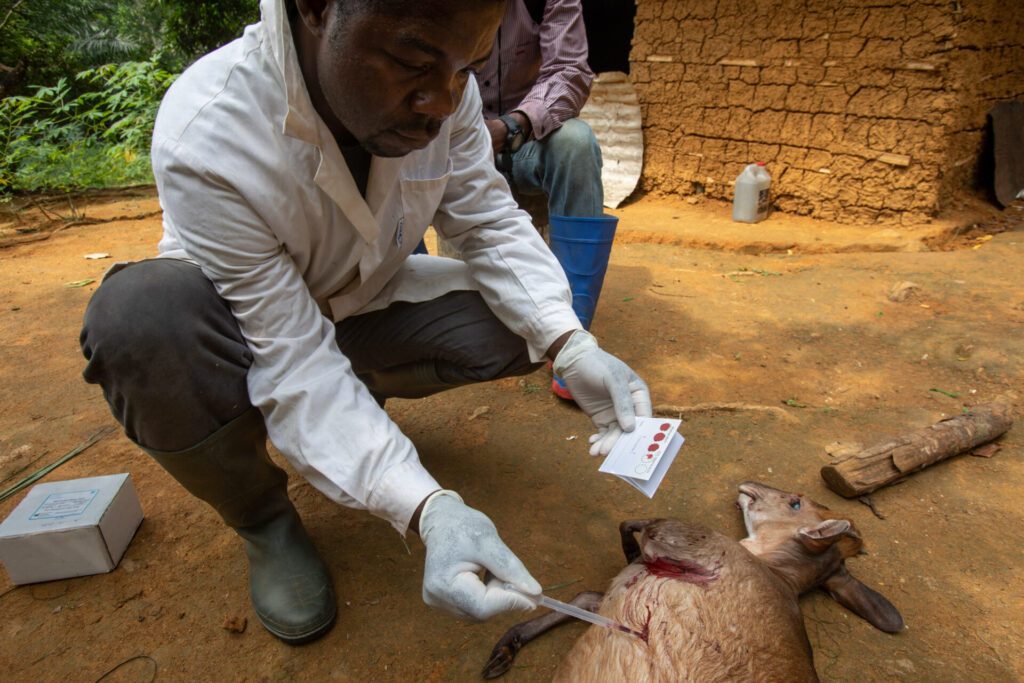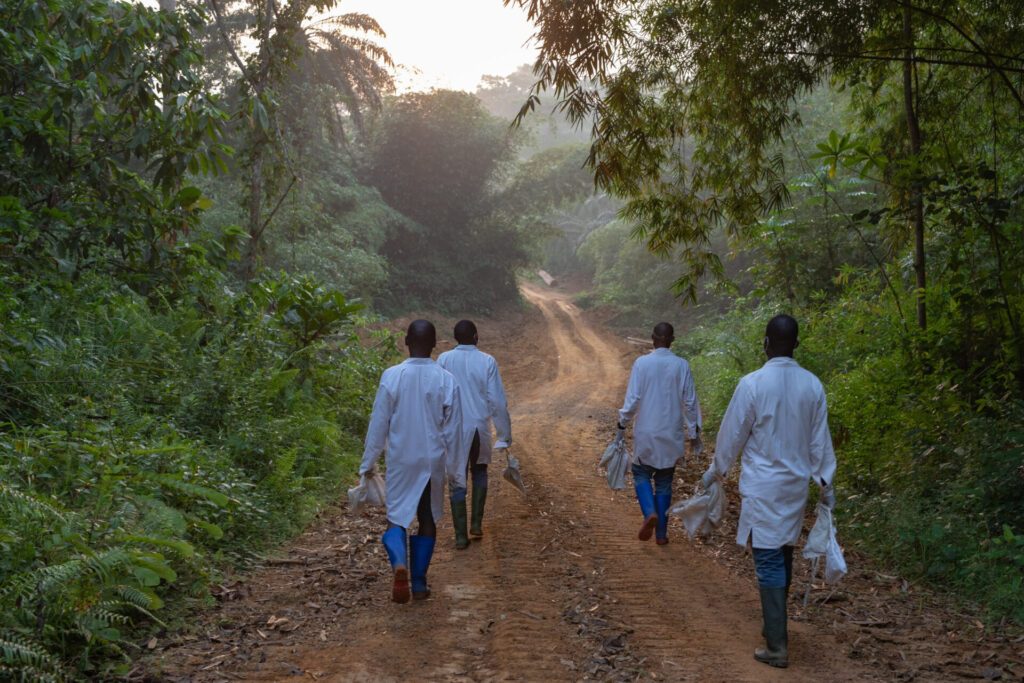EBO-SURSY Project partners with countries to develop disease surveillance protocols

The World Organisation for Animal Health (WOAH), through its EBO-SURSY Project, worked alongside countries for seven years to build their knowledge and design of surveillance networks. With the support of the European Union, the project is dedicated to preventing future outbreaks of viral haemorrhagic fevers (VHFs),
and to saving lives while also protecting wildlife health.
Establishing disease surveillance protocols are crucial in saving the lives of human and animals, and the basis of any well-functioning surveillance system. With no system in place, by the time society realises that a viral haemorrhagic fever (VHF) like Ebola is present in their community, it is often too late. Each death signals a missed opportunity for a surveillance system to anticipate and effectively prevent an outbreak in the first place.

The building blocks of a system of surveillance
While disease surveillance can be achieved in many ways, it can also be prohibitively expensive for some countries. So what makes a surveillance system successful? Professionals in a variety of disciplines are needed, all with a high level of education and frequent trainings to keep them current. In addition, countries must have a regular supply of personal protective equipment, reagent for samples of specific pathogens, and have a functioning cold chain supply, efficient laboratories, and a functional road network.
And even when a pathogen is correctly identified, the job is not finished. A country must be able to communicate about the pathogen accurately and have channels to share preventative measures with the public. Altogether, these factors create major hurdles.
EBO-SURSY Project started in 2017 to help countries overcome these barriers. Committed to helping countries develop professional skills, the project has held 11 One Health trainings across 10 countries. The project even developed communication tools to help the Veterinary Services raise awareness about disease and how to protect themselves, and shared them during trainings. Helping professionals all over Western and Central Africa, the project gave trainings on laboratory diagnostics, animal sample collection, ecological factors for diseases and more. By gathering professionals across human, environmental, and animal health (including both wildlife and livestock), EBO-SURSY encouraged developing skills and connections, while also providing a sturdy foundation for the building blocks of a surveillance system.

EBO-SURSY Project workshops on how to create a disease surveillance protocol
Of course, not every country and its professionals have the same needs. Each country is uniquely impacted by the diseases that exist in their environment. The EBO-SURSY Project convened three regional workshops (one for Central Africa, francophone West Africa, and anglophone West Africa) to train Veterinary Service and wildlife professionals on how to develop a disease protocol step by step. And each country came prepared knowing their national priority diseases. The goal of instating a disease surveillance protocol is for a country to have a ‘masterplan’ for monitoring a pathogen, and a guideline for how to react in the case of an outbreak to best control the disease from spreading.
The workshops focused on helping participants think through a protocol in a holistic manner. With professionals engaged from across the One Health spectrum from each country, the representatives from each sector could think through solutions and communication tactics in real time. WOAH stakeholders also played an important role in the workshops, and included Focal Points who are specialists in wildlife, laboratories, communications and disease notifications, as well as each Member’s Veterinary Services and Delegates. This high level of dedication was needed, because putting a disease protocol into place is no easy task, even when there is support.
Barriers to proper surveillance
Given the critical nature of a disease surveillance protocol, one might ask, why would a country not already have one? Mostly because it requires a country to have the ability to sample, test and communicate on results. Different types of surveillance sampling also necessitate various levels of effort and financial commitment.
For example, targeted surveillance in wildlife requires that regular samples are taken from animal populations. This can become expensive, as people would need to regularly locate and access these animals, have a way to trap them, and only then, sample them and submit the sample to a lab. Less wealthy countries might prioritise other diseases, or diseases impacting humans only. Otherwise, there is also passive surveillance, which while requiring similar laboratory capacities, takes samples on an ad-hoc basis from animals found unusually sick or dead. It is therefore less expensive to cover a wider area.

Despite this complexity, the EBO-SURSY Project was not deterred in helping countries build a surveillance protocol. After the success of the regional workshops, the participants were encouraged to bring their draft disease protocols home to share with their national Veterinary Services.
Some countries then asked for EBO-SURSY’s support in holding national-level workshops. Led by the national Veterinary Services, they refined the protocols involving multisectoral stakeholders in the country. Three days were needed for the technical development of the protocols, and two days to present the draft plans to national Ministries. The workshops gave countries the opportunity to broaden the health horizon to include animal and environmental health within national plans, while also building personal and professional networks across the One Health sectors.
Successfully implementing disease surveillance protocols
By the final year of the EBO-SURSY Project, many countries have achieved their goals. Sierra Leone, the Republic of the Congo, and the Central African Republic have put Rift Valley Fever protocols into place. Côte d’Ivoire now has one for Lassa fever. Even in countries where a finalised protocol was not adopted, they still made important strides in thinking critically about developing disease protocols, and these drafts could still be implemented in the future.
In other countries, such as Cameroon who already had a finalised protocol for zoonotic diseases, they used EBO-SURSY’s involvement to deepen existing plans and build the capacity of surveillance system stakeholders. The national Veterinary Services in several countries adopted EBO-SURSY VHF communication tools to build awareness in communities. By educating their populations on these diseases, community members can directly participate in surveillance, signaling to authorities when there are unusual animal health events.

The future of the health of animals, humans and even environments depend on such protocols with One Health principles. They are put into place to protect all of us. They can signal changes in disease patterns, new outbreaks, and hopefully prevent the death of humans and animals alike. While EBO-SURSY Project is soon ending, these disease surveillance protocols will improve health for years to come.
More information
-
EBO-SURSY Project
-
EBO-SURSY Impact Report: Protecting wildlife, protecting our future
-
Wildlife Portal
